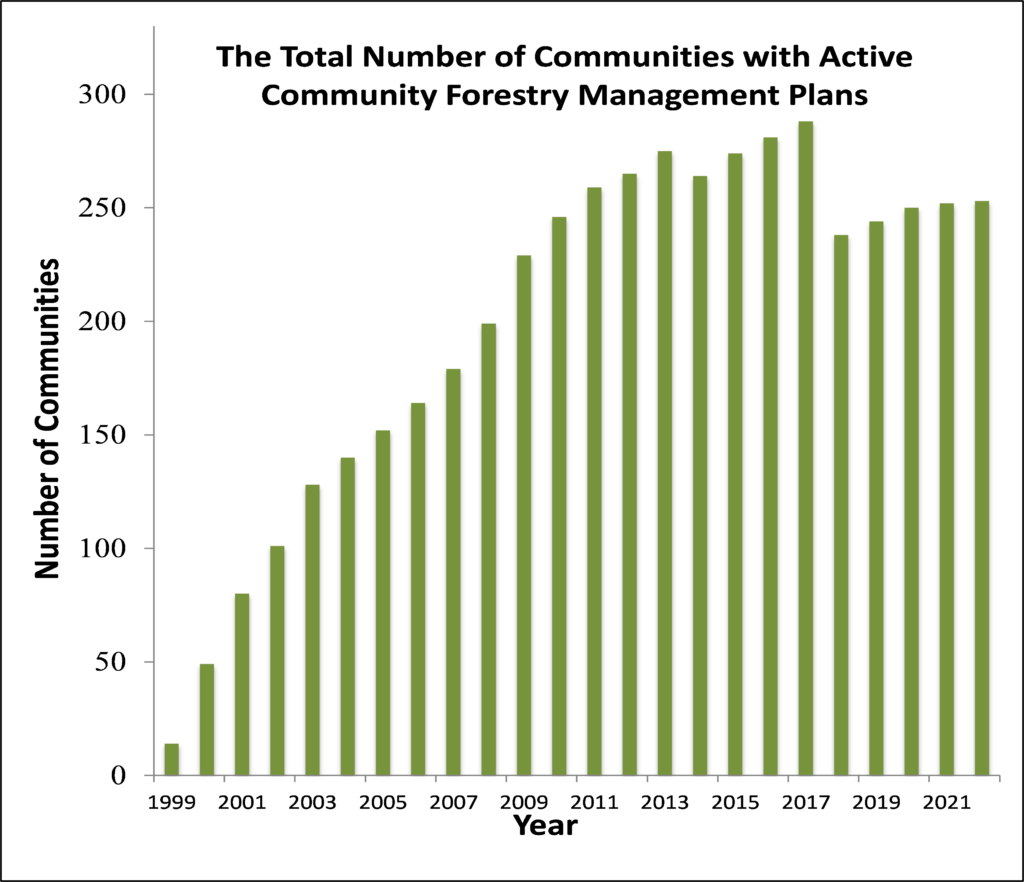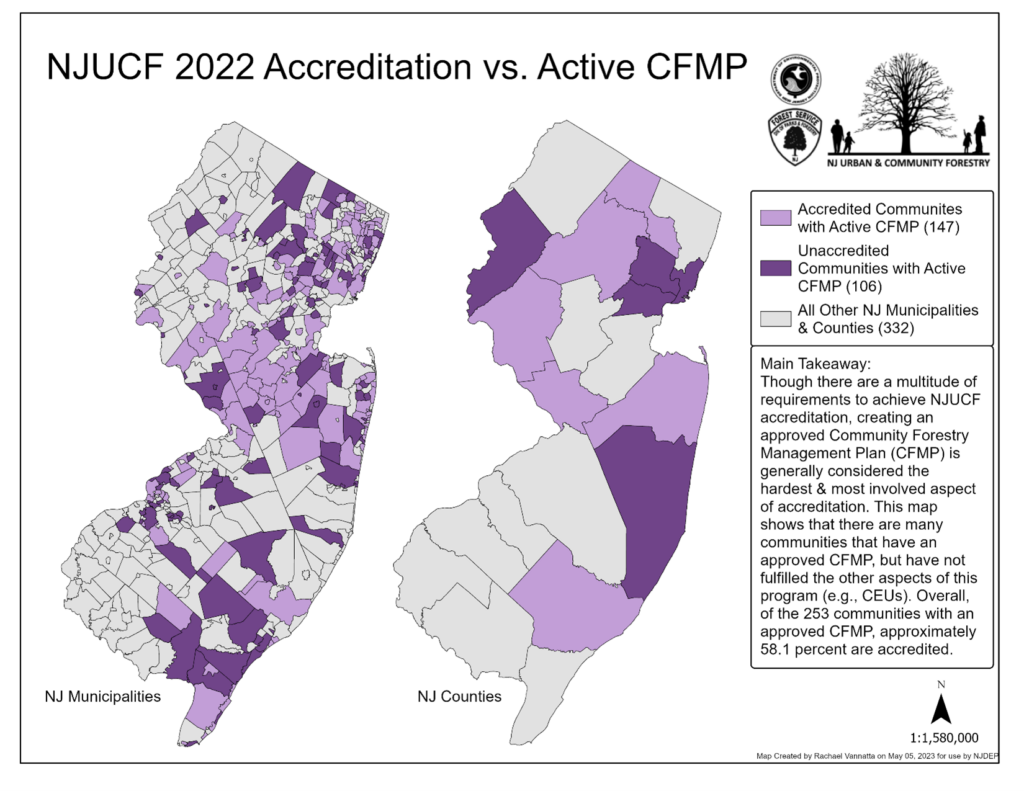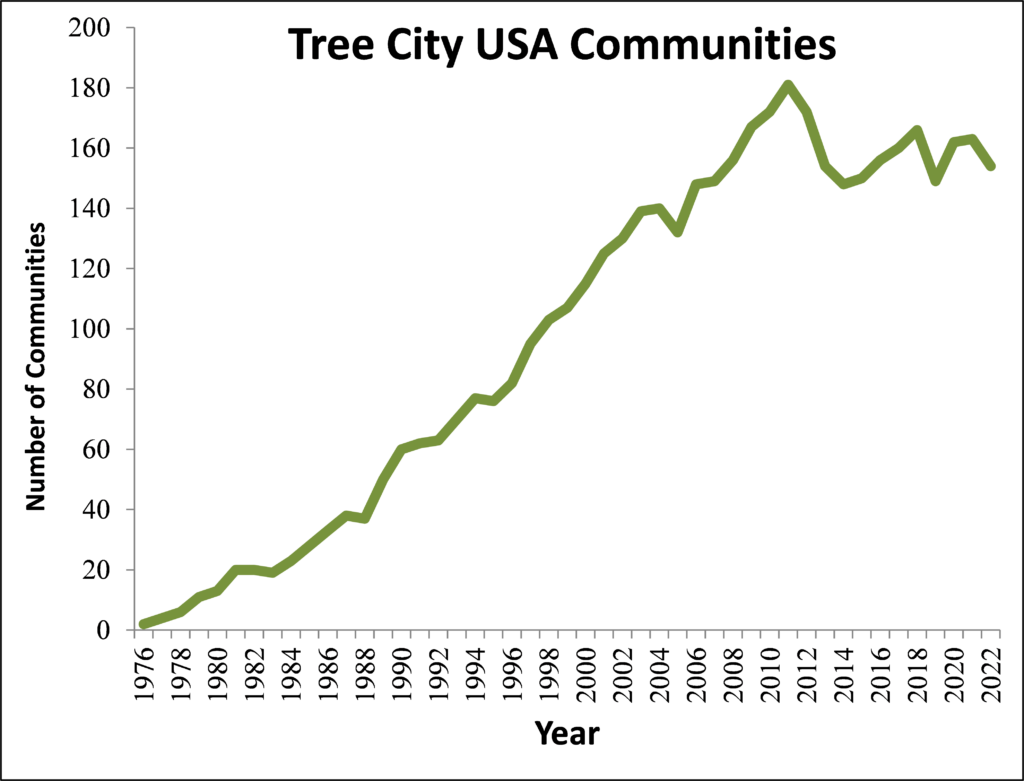In This Report:
Contact Us:
Environmental Trends Report
NJDEP, Division of Science and Research

Urban and Community Forests
Background
Urban forestry is the professional experience, science, and technology of managing trees and forest resources in urban communities for the physiological, sociological, economic, and aesthetic benefits. The urban forest is a complex ecological network that combines the natural and built environments and includes all the trees and other vegetation in and around cities and towns. Shrubs, wildflowers, ground covers, and wildlife, in context with neighborhood streets, buildings, utilities, and most importantly – people, are elements of urban and community forests.
Urban and community forestry ensures more livable communities through the stewardship (establishment, conservation, protection, and maintenance) of trees and forests. Urban and community forests provide a wide range of ecosystem services and functions including carbon storage and sequestration, air pollutant mitigation, noise buffering, stormwater mitigation, and energy savings. Trees and forests also add socioeconomic value to neighborhoods, creating an attractive and desirable living environment, improving public health, and spurning economic investment and job creation.
In 1893, the NJ Tree Ordinance Law gave towns the power to enact tree laws and establish Shade Tree Commissions. In 1990, major legislative provisions governing urban forestry were included for the first time in the Forestry rider of the federal Farm Bill. Provisions included that, “forest lands, shade trees, and open spaces in urban areas and communities improve the quality of life for residents.”1 One purpose of this addition was to “provide assistance through competitive matching grants awarded to local units of government…for urban and community forestry projects.”2
The New Jersey Shade Tree and Community Forestry Assistance Act was passed more than 25 years ago.3 This Act is unique to New Jersey and has no equal nationwide. The statute established the NJ Urban and Community Forestry program and defined its role as part of the NJ Forest Service. Its mission is to encourage and support the stewardship and effective management of trees and forest ecosystems in New Jersey communities. In addition, the Shade Tree Act, as it is commonly called, also established the NJ Community Forestry Council under the NJ Forest Service, created the Treasure our Trees license plate and provided the necessary basis for local governments in NJ to reduce or eliminate liability associated with local tree care programs and Shade Tree Commissions.
Status and Trends
Forested Area and Population Served
In a 2018 study on U.S. Urban Forest Statistics, Values, and Projections, Nowak and Greenfield reported an increase of 1.6% in urban and community land from 2000 – 2010. Urban Tree Cover was roughly 48% with approximately 179 million trees on urban/community land in New Jersey, which store about 30 million tons of carbon and annually remove about one million metric tons of carbon (a value of $57 million in avoided emissions annually).”4
In the most recent data garnered by the United States Department of Agriculture Forest Service’s Forest Inventory and Analysis in 2016, forests cover approximately 40% of the land in NJ. Of this forested land, approximately 47% is privately owned and 53% is publicly owned.5 Fourteen percent (14%) of public forested land in NJ is held by local governments.
By the end of 2010, 95% of the total population of people in New Jersey were living in urban and community areas, US Census reports predicted.6 It is important for New Jersey communities to steward their trees and forests for the dense population residing in urban areas now without compromising the resource for generations to come.
NJ Urban and Community Forestry Accreditation Program
The NJ Urban and Community Forestry program (NJUCF) assists local governments to create and maintain healthy, safe, and resilient urban and community forests, as well as self-sustaining local urban and community forestry programs through accreditation. To receive accreditation, a local government must have an approved management plan for trees and forests. A management plan is an essential guide to successfully achieving a healthy, economically efficient, and safe urban and community forest. A plan may lead to reduced tree risks, decreased tree maintenance and removal costs, fewer emergency tree calls, and increased environmental, social, and economic benefits from trees and forests. It also helps communities to develop a proactive, rather than reactive, approach to tree and forest resource management and to prioritize limited financial resources to optimize goals, objectives, and results.
In 1999, fourteen NJ municipalities developed management plans for trees and forests and were actively managing their resources. The number municipalities with management plans increased over the following twenty-three-year period, with some adjustment to the numbers in 2014 and 2018 for changes in the approval process. In 2022, there were 253 municipalities with management plans (Figure 1).
In 2020, 53% of NJ local governments had at least one management plan for trees and forests approved and 101 municipalities with overburdened communities were NJUCF Accredited. This represents 67% of all NJUCF Accredited municipalities that year. In 2022, 143 municipalities, along with several county systems, were fully accredited by the Urban and Community Forestry program (Figure 2).
Benefits of having a NJUCF Accredited local shade tree program include access to grants and a statutory basis for local governments to reduce or eliminate liability associated with local tree and forest stewardship programs.

Figure 1. Number of communities in New Jersey with approved Community Forestry Management Plan (1999-2022)

Figure 2. Number of municipalities and counties in New Jersey with accredited status for 2022
Tree City USA Program
Tree City USA is a national program of the Arbor Day Foundation that provides cities and towns across the United States with a framework for urban and community forestry management, and the opportunity to promote local work on the national stage. In 1976, there were only two Tree City USA certified communities in New Jersey, Paramus, and Parsippany-Troy Hills. Paramus was the second municipality in the nation to be certified by the Tree City USA. The number of Tree City USA communities increased gradually since then (Figure 2). That number increased more rapidly after the New Jersey Community Forestry Assistance Act was passed in 1996. By the end of 1998, the number of Tree City USA communities in New Jersey increased to 103. In general, this increasing trend continued from 1998 to 2011. There was a drop in the number of certified communities from 2012 to 2014 due to a reallocation of resources, but since then the number of communities has generally risen to the current number of 154 (Figure 3).

Figure 3. Tree City USA communities in New Jersey (1976-2022)
In 2011, New Jersey was 4th in the nation for the number of municipalities active in the program with 181 Tree City USA communities and remains in the top 5 nationwide. In 2022, NJ had 154 registered Tree City USA communities. Based on the 2010 census and 2017 Arbor Day Foundation Tree City USA reporting, 45% of NJ residents were living in a Tree City USA community.7
Outlook and Implications
By 2050, New Jersey is projected to have 64% of the state classified as urban land.8 Rapid urbanization and sprawl are associated with many environmental problems, including increased atmospheric carbon dioxide concentrations, water quality degradation, and limited greenspaces. Investment in urban and community forestry adds value that accrues over time and has an important role to play in dealing with these critical environmental issues.
Trees sequester carbon and reduce atmospheric carbon dioxide concentrations, mitigate stormwater runoff to decrease flooding, and provide better quality of life, improving human well-being. These benefits and many others are maximally realized when trees have grown to their full potential, live long lives, and can eventually be replaced by younger trees. Urban and community forestry provides towns, cities, and counties with the management tools needed to help maintain healthy trees and plan for their replacement, sustaining their benefits for future generations.
More Information
For detailed information on how municipalities receive and maintain accreditation, please visit www.communityforestry.nj.gov.
References
1Federal Farm Bill, 16 USC §2105(a)(2)
2Federal Farm Bill, 16 USC §2105(b)(4)
3N.J.A.C. 13:1L-17.1 et. seq.
4Nowak, David J., Eric J. Greenfield. 2018. US Urban Forest Statistics, Values, and Projections. J. For. 116(2):164–177doi: 10.1093/jofore/fvx004164
5Crocker, Susan J., Liknes, Greg. C. 2017. Forests of New Jersey, 2016. Resource Update FS-135. Newtown Square, PA: U.S. Department of Agriculture, Forest Service, Northern Research Station. 4 p. Accessed 11/1/2018 at: https://www.fs.fed.us/nrs/pubs/ru/ru_fs135.pdf
6U.S. Census Bureau. 2010. New Jersey: 2010: 2010 Census of Population and Housing, Issued August 2012. CPH-2-32. Accessed 12/6/2017 at: https://www.census.gov/prod/cen2010/cph-2-32.pdf
7Arbor Day Foundation. 2017. Tree City USA Communities in New Jersey. Accessed 11/1/2018 at: http://www.arborday.org/states/documents/New_Jersey.pdf
8Nowak, David J., Susan M. Stein, Paula B. Randler, Eric J. Greenfield, Sara J. Comas, Mary A. Carr, and Ralph J. Alig; United States Department of Agriculture Forest Service, Sustaining America’s Urban Trees and Forests. 2010. Accesssed 12/6/2017 at: https://www.fs.fed.us/openspace/fote/reports/nrs-62_sustaining_americas_urban.pdf